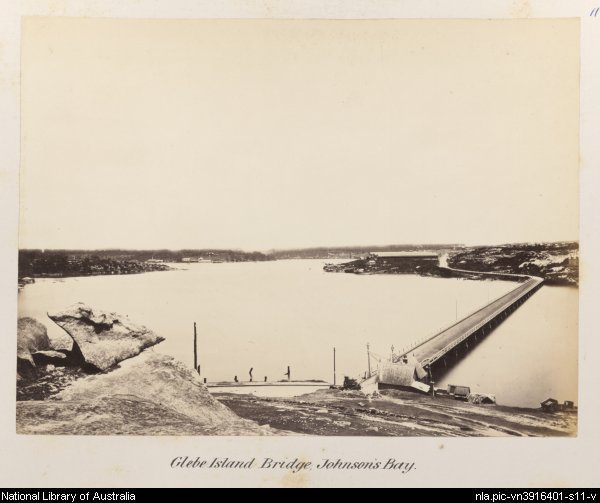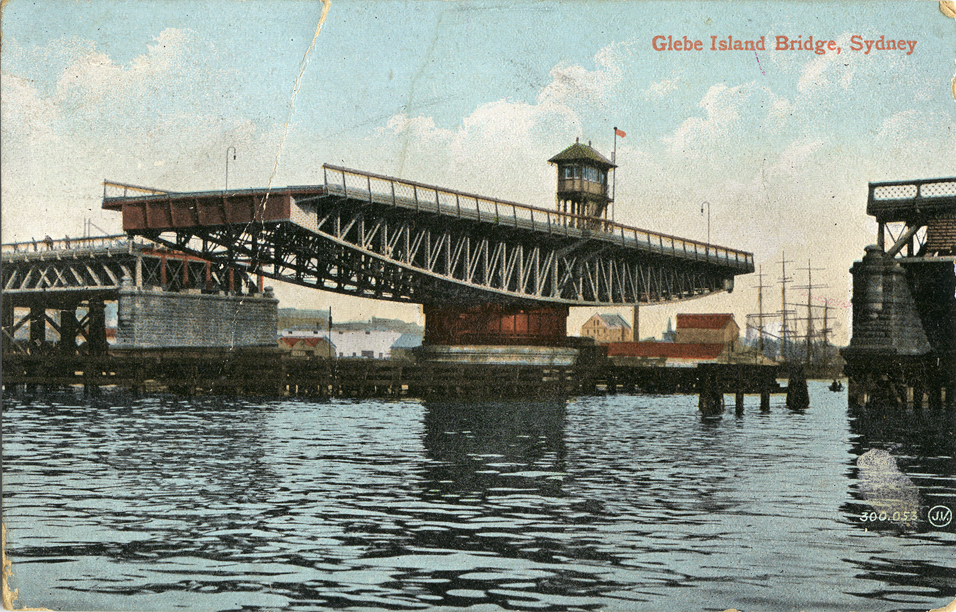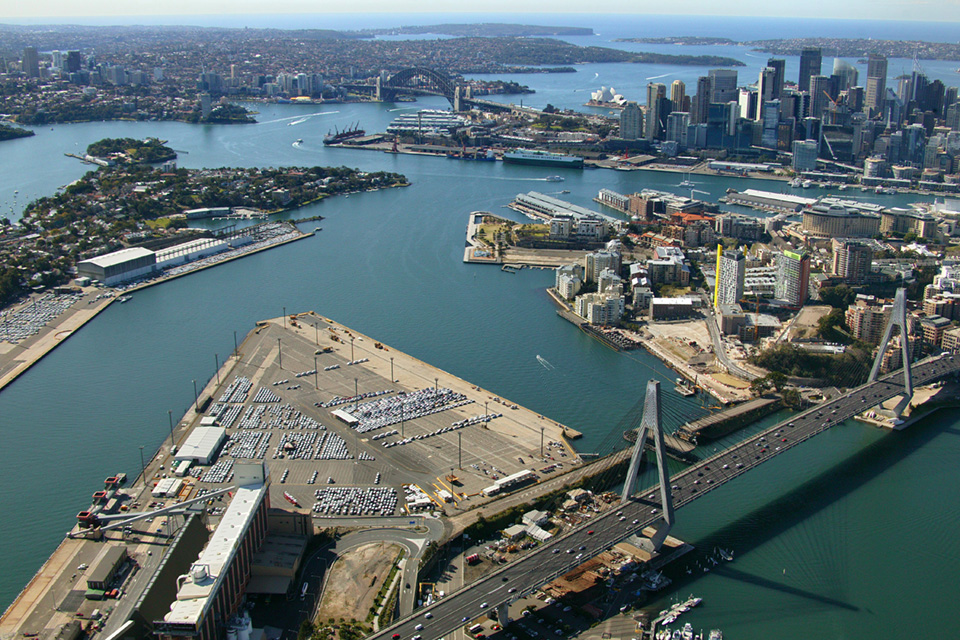The Dictionary of Sydney was archived in 2021.
Glebe Island
Citation
Persistent URL for this entry
To cite this entry in text
To cite this entry in a Wikipedia footnote citation
To cite this entry as a Wikipedia External link
Glebe Island
[media]The rocky outcrop known as Glebe Island was originally accessible from the Balmain shoreline only at low tide until a causeway was laid in the 1840s. In 1841 surveyor William Wells created a subdivision for the Balmain end of the island with four intended streets and six sections containing a total of 86 lots. [1] The subdivision did not eventuate.
Abattoirs and bridges
In 1850–54 Colonial Architect Edmund Blacket designed stone buildings for a public abattoir on the island. According to Joan Kerr, Blacket's chosen architecture was Norman in inspiration – round-headed openings and simple decoration. Kerr states that the abattoir was almost certainly based on an American design. [2]
[media]On 7 September 1860, Balmain Council resolved to approach the owners of the unsold parts of the Balmain Estate for a grant of land to build a road to the island. [3] The Pyrmont Bridge Company built a low-level timber-framed bridge that connected the island to Pyrmont, and thus to the city, in 1861. [4]
The [media]abattoirs featured prominently in the 1882 Royal Commission into noxious and offensive trades, instigated by complaints from Balmain and Glebe Point residents. [5] The commission found that in 1882, 524,415 sheep, 69,991 cattle, 31,269 pigs and 8,348 calves were slaughtered there.
[media]On 28 June 1903 the new bridge to Pyrmont, designed by Percy Allan, Assistant Engineer for Bridges in the NSW Department of Public Works, opened. [6] Like the ground-breaking Pyrmont Bridge being built at the same time, the second Glebe Island Bridge was a swing bridge swivelling on a massive central stone pivot-pier with timber-trussed side spans. The two bridges 'are among the structures standing as monuments' to Allan's skill. [7] Under the Local Government Act of 1906, the 34-acre (13.7-hectare) Glebe Island was added to the municipality of Balmain. [8]
Wharves and silos
From 1912, the Sydney Harbour Trust (later Maritime Services Board) planned broadside wharfage at Balmain East and along the southern shore of Balmain, including Glebe Island. [9] Also in 1915 the Metropolitan Meat Industry Board resolved to abolish the abattoirs and build a new facility at Homebush. [10] By 1915 Robert Saunders, the Pyrmont quarry master, had been commissioned to level the island to make it suitable for wharves. [11] Saunders's firm dumped a great quantity of excavated ballast at the eastern end of the island for wharfage. Many cubic feet of quality dimension stone, however, were carefully cut away and almost certainly used for construction projects. Some 250 of Saunders's men were still working on the island in 1920.
Glebe Island was an early success for the Harbour trust. Wharves were built on three sides of the levelled rocky outcrop from 1912. [12] The reconstructed fourth side was attached to the Rozelle shoreline as part of the extensive reclamation of Rozelle Bay and White Bay which had begun in the 1890s. [13]
Glebe Island became the site of a grain elevator and tall concrete silos, operated from 1921 by the Grain Elevators Board of NSW. [14] The 1958 Australian Encyclopaedia records that the bulk wheat terminal had a capacity of 7,500,000 bushels (202,500 tonnes). [15]
During World War II much of the island was commandeered for the United States main army depot in Sydney, but bulk handling of grain continued until 1990 when the wheat terminal was transferred to Port Kembla and the wharfage remodelled for containerised cargo. [16] Until November 2008, the island was the AAT terminal for imported motor vehicles. Some silos were demolished, while from 1991 Australian Cement (now Cement Australia) used 16 of them as a bulk cement terminal. These are now heritage-listed.
[media]In the 1990s a high-level, cable-stayed, reinforced concrete six-lane bridge spanning 345 metres between two 120-metre towers was built above the older Allan-designed Glebe Island Bridge. [17] Named Anzac Bridge, the arterial structure opened on 3 December 1995. [18]
In the lead up to the Sydney Olympics in 2000, the silos were painted to mimic Grecian columns and a massive entablature was attached to the top of the structure to take advertising. With the lack of research characteristic of such claims, it is often referred to as 'the largest billboard in the southern hemisphere'.
Notes
[1] WH Wells, Plan of a Part of the Glebe Island Situate between Balmain, Pyrmont and The Glebe for Sale by Auction by Mr Stubbs on Monday July 12th 1841
[2] Joan Kerr, Our Great Victorian Architect, Edmund Thomas Blacket (1817–1883), National Trust, Sydney, 1983, pp 74–75
[3] Balmain Council Minutes, minute 218, 7 September 1860
[4] 'Select Committee on the Pyrmont Bridge Company Bill (amended)', NSW Legislative Assembly Votes and Proceedings, 1858, vol 2; Pyrmont Bridge Co – half-yearly meeting, NSW Government Gazette, 1863, p 1619
[5] 'Report of the Royal Commission appointed on the 20th November, 1882, to inquire into the nature and operations of, and to classify noxious and offensive trades within the city of Sydney and its suburbs and to report generally on such trades; together with the Minutes of Evidence and Appendices ordered by the Council to be printed, 31 May, 1863', Journal Legislative Council, NSW 1883, Second Session, vol 25, p 194
[6] L Coltheart and D Fraser, Landmarks in Public Works: engineers and their works in New South Wales, 1884–1914, Hale and Iremonger, Sydney, 1987, p 72 (illustration)
[7] Arthur Corbett, 'Allan, Percy (1861–1930)', Australian Dictionary of Biography, vol 7, Melbourne University Press, Melbourne, 1979, pp 36–37
[8] Souvenir to Commemorate the 50th Anniversary of the Incorporation of the Municipality of Balmain 1860–1910, p 35
[9] Leichhardt Historical Journal, 14, 1985, p 57 (illustration)
[10] R Irving, Paradise Purgatory Hell Hole: The Story of the Saunders Sandstone Quarries, Pyrmont, Media Masters, Singapore, 2006, p 50
[11] R Irving, Paradise Purgatory Hell Hole: The Story of the Saunders Sandstone Quarries, Pyrmont, Media Masters, Singapore, 2006, p 50
[12] P Proudfoot, 'The Extension of Maritime Activity in Sydney: Pyrmont, Glebe Island and Balmain 1890–1950', The Great Circle, vol 10, 1988, pp 110–135
[13] Land and Property Information NSW, Central Mapping Authority Sheets U0945-32, U0945-33, note 33
[14] Peninsula Observer no 210, February 1992
[15] 'Ports and Harbours', Australian Encyclopaedia, Angus and Robertson, Sydney 1958, vol 7, p 211
[16] Peninsula Observer No 210, February 1992
[17] Roads and Transport Authority NSW brochure, June 1993
[18] Daily Telegraph, 4 December 1995, pp 33–40
.







